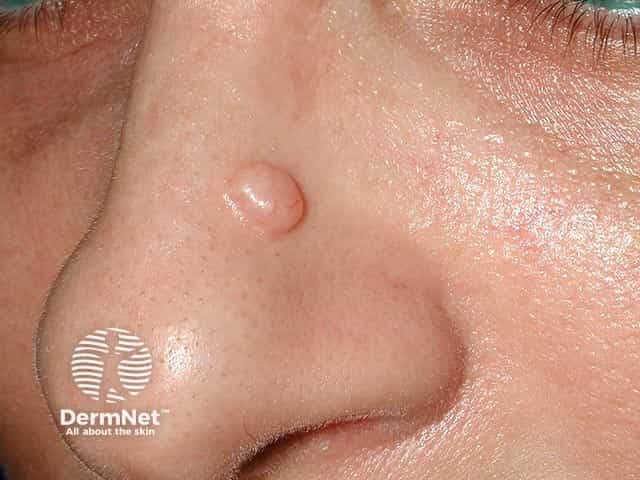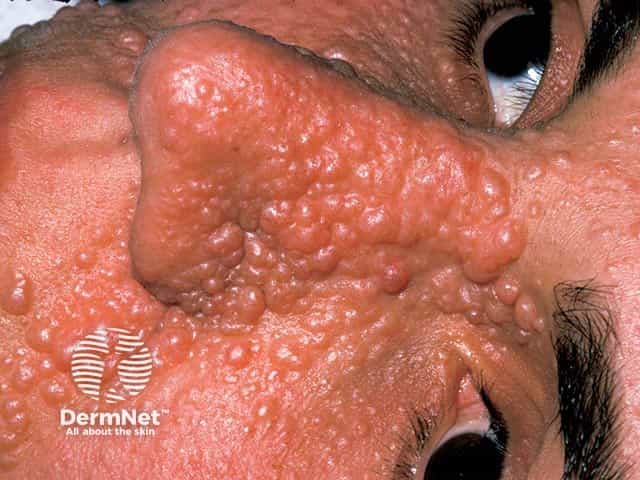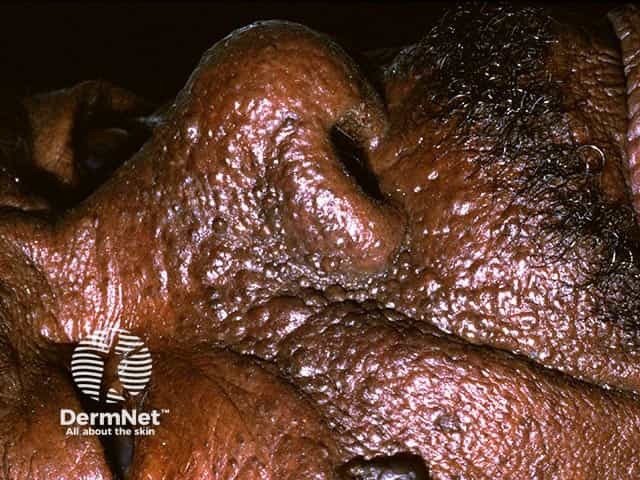Main menu
Common skin conditions

NEWS
Join DermNet PRO
Read more
Quick links
Author(s): Dr Pryia Hoonjan, MD, Dermatology, University Hospitals of Leicester, United Kingdom (2023)
Previous contributor(s): Dr Amanda Oakley, Dermatologist (1997)
Reviewing dermatologist: Dr Ian Coulson
Edited by the DermNet content department
Introduction
Demographics
Causes
Clinical features
Variation in skin types
Complications
Diagnosis
Differential diagnosis
Treatment
Prevention
Outcome
Trichoepithelioma is a rare benign skin neoplasm that arises from hair follicles.
It is classified as a benign adnexal tumour and most commonly appears as either a solitary lesion or multiple nodules on the face. They do not cause ulceration or itching and are generally considered harmless. Multiple lesions are usually inherited.
Trichoepithelioma is similar to trichoblastoma in that both are hair follicle tumours. However, trichoepitheliomas are more superficial whereas trichoblastomas tend to arise from the deep dermis.

A solitary trichoepithelioma on the nose

Multiple trichoepitheliomata — his mother and sister are similarly affected

A solitary desmoplastic trichoepithelioma

Multiple familial trichoepitheliomata in skin of colour
Due to an autosomal dominant inheritance pattern, both males and females acquire the gene for multiple trichoepitheliomata. However, females are more commonly affected due to higher gene expression.
Multiple trichoepitheliomata typically start to develop in early childhood or around puberty while solitary trichoepitheliomas often present in the second or third decades of life. Overall, trichoepitheliomata are most often diagnosed in adult women.
The prevalence is unknown. However, one dermatopathology lab in the United States reported 2.14–2.75 cases of trichoepithelioma per year.
Conditions associated with trichoepitheliomata include Brooke-Spiegler syndrome, characterised by multiple familial trichoepitheliomata, and familial cylindromatosis.
Trichoepithelioma is caused by the benign proliferation of epithelial-mesenchymal cells (basal cells) of hair follicles. There are three variants: solitary, multiple, and desmoplastic.
These tumours are small (usually 1 cm in diameter), firm, round, flesh-coloured papules typically seen on the face, particularly the upper lip, nasolabial folds, nose, eyelids, and forehead. They are sometimes also seen on the scalp, neck, upper torso, or elsewhere on the body, and can be pink-blue in colour with a symmetrical distribution.
The desmoplastic trichoepithelioma is a solitary ring-shaped lesion which can mimic the appearance of a basal cell carcinoma.
Trichoepithelioma presents similarly in different types of skin.
Treatment options include:
Currently unknown.
Most patients with trichoepithelioma have an excellent prognosis. After excision of solitary nodules, recurrence is very rare. However, as trichoepithelioma has a similar histology to basal cells, there is a small risk of malignant transformation into basal cell carcinoma.